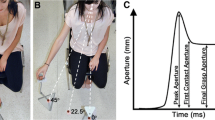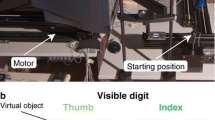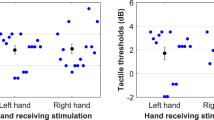Abstract
The Dual Visuomotor Channel theory proposes that skilled reaching is composed of a Reach that directs the hand in relation to the extrinsic properties of an object (e.g., location) and a Grasp that opens and closes the hand in relation to the intrinsic properties of an object (e.g., size). While Reach and Grasp movements are often guided by vision, they can also be performed without vision when reaching for a body part or an object on one’s own body. Memory of a recently touched but unseen object can also be used to guide Reach and Grasp movements although the touch-response memory durations described are extremely brief (Karl et al. in Exp Brain Res 219:59–74, 2012a). The purpose of the present study was to determine whether repeated nonvisual reaching for a consistent object could calibrate Reach and Grasp movements in a way similar to those guided by vision. The nonvision group wore vision-occluding goggles and reached for fifty consecutive trials for a round donut ball placed on a pedestal. The control group performed the same task with vision. Frame-by-frame video analysis and linear kinematics revealed that nonvision participants consistently used an elevated Reach trajectory, in which the hand, rather than being directed toward the target in the horizontal plane, was first elevated above the target before being lowered to touch and locate it. First contact was established with the dorsal surface of the target, and thus, adjustments in contact locations were often required for purchase. Although nonvision participants initially used an open and extended hand during transport, with practice they began to scale digit aperture to object size with an accuracy and temporal relation similar to vision participants. The different ways in which the Reach and Grasp movements respond to nonvisual learning are discussed in relation to support for the dual channel theory of reaching and to the idea that the Reach and Grasp channels may be differentially dependent on online visual guidance.











Similar content being viewed by others
References
Anema HA, van Zandvoort MJE, de Haan EH, Kappelle LJ, de Kort PLM, Jansen BPW, Dijkerman HC (2009) A double dissociation between somatosensory processing for perception and action. Neuropsychologia 47:1615–1620
Arbib MA (1981) Perceptual structures and distributed motor control. In: Brooks VB (ed) Handbook of Physiology, section 1, vol 2, part 2. American Psychological Society, Bethesda, MD, pp 1449–1480
Bernier P-M, Grafton ST (2010) Human posterior parietal cortex flexibly determines reference frames for reaching based on sensory context. Neuron 68:776–788
Bingham G, Coats R, Mon-Williams M (2007) Natural prehension in trials without haptic feedback but only when calibration is allowed. Neuropsychologia 45:288–294
Binkofski F, Dohle C, Posse S, Stephan KM, Hefter H, Seitz RJ, Freund HJ (1998) Human anterior intraparietal area subserves prehension: a combined lesion and functional MRI activation study. Neurology 50:1253–1259
Binkofski F, Buccino G, Posse S, Seitz RJ, Rizzolatti G, Freund H (1999) A fronto-parietal circuit for object manipulation in man: evidence from an fMRI-study. Eur J Neurosci 11:3276–3286
Borra E, Belmalih A, Calzavara R, Gerbella M, Murata A, Rozzi S, Luppino G (2008) Cortical connections of the macaque anterior intraparietal (AIP) area. Cereb Cortex 18:1094–1111
Cavina-Pratesi C, Ietswaart M, Humphreys GW, Lestou V, Milner AD (2010a) Impaired grasping in a patient with optic ataxia: primary visuomotor deficit or secondary consequence of misreaching? Neuropsychologia 48:226–234
Cavina-Pratesi C, Monaco S, Fattori P, Galletti C, McAdam TD, Quinlan DJ, Goodale MA, Culham JC (2010b) Functional magnetic resonance imaging reveals the neural substrates of arm transport and grip formation in reach-to-grasp actions in humans. J Neurosci 30:10306–10323
de Bruin N, Sacrey LA, Brown LA, Doan J, Whishaw IQ (2008) Visual guidance for hand advance but not hand withdrawal in a reach-to-eat task in adult humans: reaching is a composite movement. J Mot Behav 40:337–346
Dijkerman HC, de Haan EH (2007) Somatosensory processes subserving perception and action. Behav Brain Sci 30:189–201
Edwards MG, Wing AM, Stevens J, Humphreys GW (2005) Knowing your nose better than your thumb: measures of ober-grasp reveal that face-parts are special for grasping. Exp Brain Res 161:72–80
Fattori P, Kutz DF, Breveglieri R, Marzocchi N, Galletti C (2005) Spatial tuning of reaching activity in the medial parieto-occipital cortex (area V6A) or macaque monkey. Eur J Neurosci 22:956–972
Faul F, Erdfelder E, Lang A-G, Buchner A (2007) G*Power 3: a flexible statistical power analysis program for the social, behavioural, and biomedical science. Behav Res Methods 39:175–191
Gentilucci M, Daprati E, Toni I, Chieffi S, Saetti MC (1995) Unconscious updating of grasp motor program. Exp Brain Res 105:291–303
Georgopoulos AP, Grillner S (1989) Visuomotor coordination in reaching and locomotion. Science 245:1209–1210
Gharbawie OA, Stepniewska I, Kaas JS (2011) Cortical connections of functional zones in posterior parietal cortex and frontal cortex motor regions in new world monkeys. Cereb Cortex 21:1981–2002
Goodale MA, Milner AD (1992) Separate visual pathways for perception and action. Trends Neurosci 15:20–25
Goodale MA, Jakobson LS, Keillor JM (1994a) Differences in the visual control of pantomimed and natural grasping movements. Neuropsychologia 32:1159–1178
Goodale MA, Meenan JP, Bulthoff HH, Nicolle DA, Murphy KJ, Racicot CI (1994b) Separate neural pathways for the visual analysis of object shapes in perception and prehension. Curr Biol 4:604–610
Hu Y, Eagleson R, Goodale MA (1999) The effects of delay on the kinematics of grasping. Exp Brain Res 126:109–116
Iberall T, Bingham G, Arbib MA (1986) Opposition space as a structuring concept for the analysis of skilled hand movements. In: Heuer H, Fromm C (eds) Generation and moduclation of action patterns. Experimental Brain Research Series, vol 15. Springer, Berlin, pp 158–173
Jakobson LS, Goodale MA (1991) Factors affecting higher-order movement planning: a kinematic analysis of human prehension. Exp Brain Res 86:199–208
James TW, Humphrey GK, Gati JS, Servos P, Menon RS, Goodale MA (2002) Haptic study of three-dimensional objects activates extrastriate visual areas. Neuropsychologia 40:1706–1714
Jeannerod M (1981) Intersegmental coordination during reaching at natural visual objects. In: Long J, Badeley A (eds) Attention and performance IX. Lawrence Erlbaum Associates, Hillsdale, pp 153–169
Jeannerod M (1999) Visuomotor channels: their integration in goal-directed prehension. Hum Mov Sci 18:201–218
Jeannerod M, Decety J, Michael F (1994) Impairment of grasping movements following bilateral posterior parietal lesion. Neuropsychologia 32:369–380
Jeannerod M, Arbib MA, Rizzolatti G, Sakata H (1995) Grasping objects: the cortical mechanisms of visuomotor transformation. Trends Neurosci 18:314–320
Jeannerod M, Paulignan Y, Weiss P (1998) Grasping an object: one movement, several components. Novartis Found Symp 218:16–20
Kaas JH, Gharbawie OA, Stepniewska I (2011) The organization and evolution of dorsal stream multisensory motor pathways in primates. Front Neuroanat 5:1–7
Karl JM, Sacrey LA, Doan JB, Whishaw IQ (2012a) Hand shaping using hapsis resembles visually guided hand shaping. Exp Brain Res 219:59–74
Karl JM, Sacrey LA, Doan JB, Whishaw IQ (2012b) Oral hapsis guides accurate hand preshaping for grasping food targets in the mouth. Exp Brain Res 221:223–240
Murata A, Gallese V, Luppino G, Kaseda M, Sakata H (2000) Selectivity for the shape, size, and orientation of objects for grasping in neurons of monkey parietal area AIP. J Neurophysiol 83:2580–2601
Napier JR (1956) The prehensile movements of the human hand. J Bone Joint Surg Am 38-B:902–913
Napier JR (1980) Hands. Princeton University Press, Princeton
Opitz D, Gegenfurtner KR, Bulthoff HH (1996) A comparison of grasping real and virtual objects. Perception 25:92–93
Pettypiece CE, Culham JC, Goodale MA (2009) Differential effects of delay upon visually and haptically guided grasping and perceptual judgments. Exp Brain Res 195:473–479
Pettypiece CE, Goodale MA, Culham JC (2010) Integration of haptic and visual size cues in perception and action revealed through cross-modal conflict. Exp Brain Res 201:863–873
Rizzolatti G, Matelli M (2003) Two different streams form the dorsal visual system: anatomy and functions. Exp Brain Res 153:146–157
Rizzolatti G, Luppino G, Matelli M (1998) The organization of the cortical motor system: new concepts. Electroencephalogr Clin Neurophysiol 106:283–296
Safstrom D, Edin BB (2004) Task requirements influence sensory integration during grasping in humans. Learn Mem 11:356–363
Safstrom D, Edin BB (2008) Prediction of object contact during grasping. Exp Brain Res 190:265–277
Sakata H, Taira M, Kusunoki M, Murata A, Tanaka Y, Tsutsui K (1998) Neural coding of 3D features of objects for hand action in the parietal cortex of the monkey. Philos Trans R Soc Lond B Biol Sci 353:1363–1373
Sartori L, Staulino E, Castiello U (2011) How objects are grasped: the interplay between affordances and end-goals. PLoS One 6:e25203
Schmidt RA, Lee TD (2011) Motor control and learning: a behavioral emphasis, 5th edn. Human Kinetics, Champaign Il
Shallice T, Venable N, Rumiati RI (2005) Dissociable distal and proximal motor components: evidence from perseverative errors in three apraxic patients. Cogn Neuropsychol 22:625–639
Smeets JB, Brenner E (1999) A new view on grasping. Mot Control 3:237–271
Snyder LH, Ap Batista, Andersen RA (1997) Coding of intention in the posterior parietal cortex. Nature 386:167–170
Stelmach GE, Castiello U, Jeannerod M (1994) Orienting the finger opposition space during prehension movement. J Mot Behav 26:178–186
Tanne-Gariepy J, Rouiller EM, Boussaoud D (2002) Parietal inputs to dorsal versus ventral premotor areas in the macaque monkey: evidence for largely segregated visuomotor pathways. Exp Brain Res 145:91–103
Valyear KF, Chapman CS, Gallivan JP, Mark RS, Culham JC (2011) To use or to move: goal-set modulates priming when grasping real tools. Exp Brain Res 212:125–142
Whishaw IQ (2003) Did a change in sensory control of skilled movements stimulate the evolution of the primate frontal cortex? Behav Brain Res 146:31–41
Whishaw IQ, Suchowersky O, Davis L, Sarna J, Metz GA, Pellis SM (2002) Impairment of pronation, supination, and body coordination in reach-to-grasp tasks in human Parkinson’s disease (PD) reveals homology to deficits in animal models. Behav Brain Res 47:59–70
Wing AM, Turton A, Fraser C (1986) Grasp size and accuracy of approach in reaching. J Mot Behav 18:245–260
Acknowledgments
The authors would like to thank two anonymous reviewers for helpful comments on an earlier draft of this paper. This research was supported by the Natural Sciences and Engineering Research Council of Canada (JMK, IQW), Alberta Innovates-Health Solutions (JMK), and Canadian Institutes of Health Research (IQW).
Author information
Authors and Affiliations
Corresponding author
Rights and permissions
About this article
Cite this article
Karl, J.M., Schneider, L.R. & Whishaw, I.Q. Nonvisual learning of intrinsic object properties in a reaching task dissociates grasp from reach. Exp Brain Res 225, 465–477 (2013). https://doi.org/10.1007/s00221-012-3386-z
Received:
Accepted:
Published:
Issue Date:
DOI: https://doi.org/10.1007/s00221-012-3386-z




